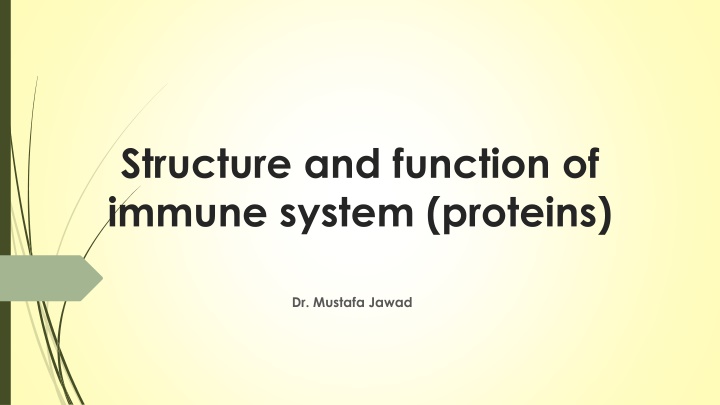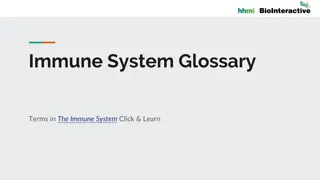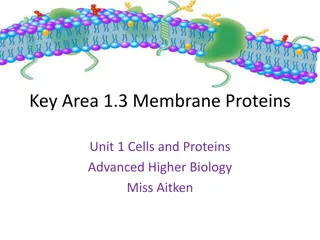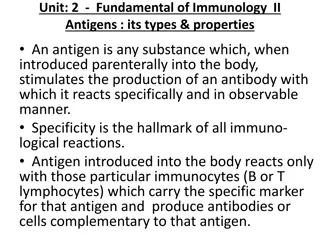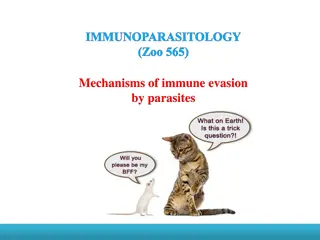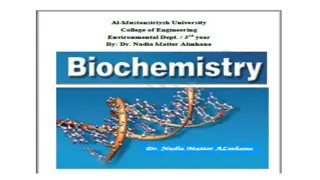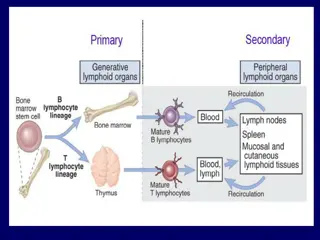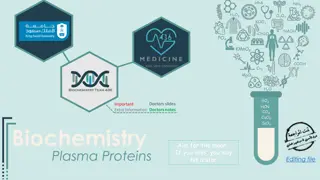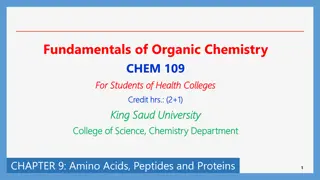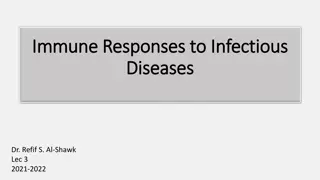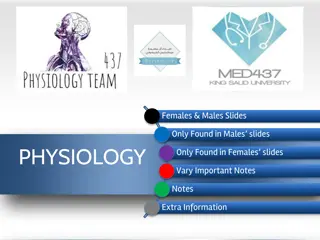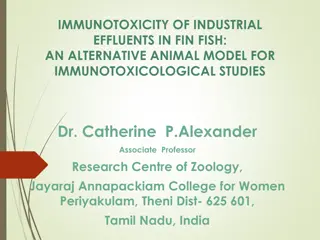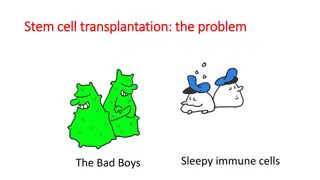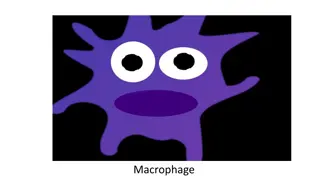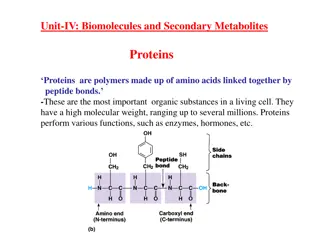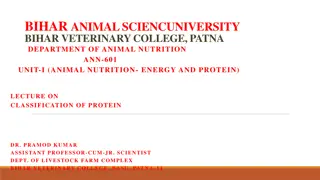Structure and Function of Immune System Proteins
The proteins of the immune system play crucial roles in regulating various biological processes, including immune response, wound healing, and more. This includes structural proteins like MHC system and soluble proteins like antibodies and cytokines. Cytokines, in particular, act as intercellular messengers with diverse effects on target cells, exhibiting properties like pleiotropy, redundancy, synergy, antagonism, and cascade induction. Interleukin-1 (IL-1) is a key cytokine that influences a wide range of cellular and physiological processes, serving as an important mediator in immune responses and inflammatory reactions.
Download Presentation

Please find below an Image/Link to download the presentation.
The content on the website is provided AS IS for your information and personal use only. It may not be sold, licensed, or shared on other websites without obtaining consent from the author.If you encounter any issues during the download, it is possible that the publisher has removed the file from their server.
You are allowed to download the files provided on this website for personal or commercial use, subject to the condition that they are used lawfully. All files are the property of their respective owners.
The content on the website is provided AS IS for your information and personal use only. It may not be sold, licensed, or shared on other websites without obtaining consent from the author.
E N D
Presentation Transcript
Structure and function of immune system (proteins) Dr. Mustafa Jawad
Introduction The proteins of immune system include : structural proteins, soluble proteins Structural proteins include: surface proteins such as MHC system (HLA), cytokine receptors, surface antibodies Soluble proteins include: antibodies, complements, cytokines, lymphokine, monokine The cytokine include: 1- cytokine affecting lymphocytes 2- cytokine affecting macrophage 3- Cytotoxic cytokine
Cytokines Cytokines are soluble mediators, glycoprotein in nature, produced by and act on various immune and non immune cells. They are the intercellular messengers not only regulate immune and inflammatory response, but also wound healing, hematopoiesis, angiogenesis and many other biological processes. Cytokines exhibit the following properties: Pleiotropy: has different biological effects on different target cells Redundancy: two or more cytokines mediate similar function Synergy: combined effect of two cytokines is greater than the effect of individual cytokine Antagonism: the effect of one cytokine is inhibited by another cytokine Cascade induction: action of cytokine on the target cell induces production of cytokines, which in turn may induce other target cells to produce other cytokines
Interleukin-1 (IL-1) It was previously known as endogenous pyrogen (producing fever), lymphocyte-activating factor (LAF). IL-1 is produced by many cells such as macrophages, endothelial cells, B cells, fibroblast, but macrophages produce IL-1 abundantly. It stimulates T and B cells and induces inflammatory responses. IL-1 together with TNF goes to brain, where they induces fever and act to increase corticosteroid release. In the liver, it induces production of acute phase proteins. It mediates a wide range of metabolic, physiological inflammatory and hematological effects by acting on bone marrow, epithelial cells, fibroblasts, osteoclasts, hepatic cells, etc. Virtually, all cells of the body have receptors for IL-1 and can respond to it
Interleukin-1 IL-1 produced by many cell types in response to damage, infection or antigens. 1- It influences many cells and processes. 2- NK cell-cytocidal activity increases; 3- Polymorphonuclear neutrophils metabolically activated and move towards the site of IL-1 production by chemotaxis (black arrow); 4- In the endothelium, adhesion molecules and procoagulants are induced and permeability is increased; 5- Prostaglandin production and cytocidal activity increase in macrophages. Chemotaxis is also stimulated (black arrow); 6- Th cell proliferation, IL-2 receptor expression and cytokine production are all enhanced; 7- B cell proliferation and differentiation into antibody- forming cells (AFCs) is stimulated and regulated By other cytokines (PMNs) are
Interleukin-2 (IL-2), Interleukin-3 (IL-3) Interleukin-2 (IL-2): Previously, it was known as T-cell growth factor (TCGF). IL-2 is chiefly produced by Th 1 cell of CD4+ series and also by CD8+ cells. It has action on restricted range of cells, chiefly on T cells. It also acts on NK cells and B cells. It transforms some null cells large granular lymphocytes (LGL) to lymphokine activated killer cells (LAK cells), which can kill cancer cells. Interleukin-3 (IL-3): It is a growth factor for bone marrow stem cells produced by T-cells It is called multi-colony stimulating factor (CSF), as it stimulates the growth of precursors of all the hematopoietic lineage cells.
Interleukin-4 (IL-4),(IL-5), (IL-6): Interleukin-4 (IL-4): Earlier it was called B cell- activator or differentiating factor. It is secreted by activated T cells (Th2). It acts on B cell to induce differentiation to produce IgG1 and IgE. It also acts on T cells as a growth and activation factor for Th2 differentiation. IL-4 is secreted by Th2 cells, mast cells and a subset of NK cells. IL-4 is now best known for the role it plays in allergic diseases by promoting IgE production. Interleukin-5 (IL-5): Originally, it was described as a B cell growth factor (BCGF) in mice, but functions mainly as an eosinophil growth and differentiation factor in humans. Th2 cells are the main source of IL-5. Interleukin 6 (IL-6) It is produced by stimulated T and B-cells, macrophages and fibroblasts It promotes differentiation of B-cells into Ab-producing plasma cells and encourages IgG production It acts as an inflammatory response mediator in host defense against infections
IL-7, IL-8, IL-9, IL-10, IL-11 lnterleukin-7 (IL-7) It is produced by the spleen, bone marrow stromal cells (BMSCs) It is B and T-cells growth factor Interleukin-8 (IL-8) It is produced by macrophages and other cells It acts as neutrophil chemotactic factor Interleukin-9(IL-9) It is produced by T-cells It helps in cell growth and proliferation Interleukin-10 (IL-10) It is produced by T and B-cells and macrophages It inhibits interferon production and functions of mononuclear cells Interleukin-11 (IL-11) It is produced by bone marrow stromal cells It induces acute phase proteins
IL-12, IL-13, IL-17, IL-18, Transfer factor (TF) Interleukin-12 (IL-12) It is produced by T-cells, It activates NK cells lnterleukin-13 (IL-13): It is produced by T-cells, It inhibits functions of mononuclear cells Interleukin-17 (IL-17): It is produced by activated memory T cells and binds to the receptors on many cells, particularly on cells of the spleen and kidney. IL-17 induces the target cells to express IL-6, IL-8 and granulocyte macrophage colony stimulating factor (GM- CSF). It stimulates neutrophil precursor cells. Interleukin-18 (IL-18): It is produced by keratinocytes and macrophages. It is structurally related to IL-1. It potentiates IFN- and GM- CSF production by T, B and NK cell and promotes Th2 differentiation. Transfer factor (TF) It is an extract from specific antigen-sensitized lymphocytes that mediates passive transfer of CMI is known as transfer factor It is useful in immunocompromised individuals to restore specific CMI, e.g. in T-cell deficiency Disseminated infections associated with deficient CMI ( tuberculosis, lepromatous leprosy, mucocutaneous candidiasis, etc.) Cancer-melanoma, sarcoma, etc.
Interferons (Antiviral Cytokines) Interferon consists of a large family of secretory proteins that not only share antiviral activity, but also have the ability to inhibit the growth of cells and to modulate immune responses. There are three classes of interferons: IFN- , IFN- and IFN- . Both IFN- and IFN- are produced by leukocytes and fibroblasts respectively and have cell growth inhibition and antiviral property. The IFN- is produced by activated T cells and NK cells. It is an immune modulator through weakly antiviral. IFN- induces transformation of ordinary macrophage to activated macrophage, to deal better against the intracellular bacterial infection. Further, it increases APC function by inducing MHC class II molecules. Excessive production of IFN- can play a part in the induction of autoimmunity.
Biological functions of Cytokines Cytokines are involved in a wide range of biological activities including innate immunity, adaptive immunity, inflammation, wound healing and hematopoiesis. Presently, the number of proteins with cytokine activity exceeds 100. As the time passes, new ones are added to the list. Unlike antibody, which acts specifically with its antigen, the cytokines act in an antigen non-specific manner. That is they affect, whatever cells they encounter that bears appropriate receptors and are in a physiological state that allows them to respond.
NON interleukin cytokine Major properties of human non-interleukin cytokines Principal cell source Activated macrophages, other somatic cells necrosis. Activated Th1 cells IL-1 like and TNF- like effects. Macrophage, neutrophils, etc. cells, activation of macrophages and NK|| cells Activated Th1 and NK cells class II MHC on APCs . Activation of macrophages neutrophils and NK cells; promotion of CMI** (inhibits Th2 cells); antiviral effect (weak) Monocytes, macrophages fibroblasts, T lymphocytes mature blood cell types from pluripotent stem cells Cytokine TNF- * Principal effects IL-1 like effects, vascular thrombosis and tumor TNF- IFN- and Antiviral effect, induction of class I MHC on somatic IFN- Induction of class I MHC on all somatic cells; induction of These cytokines help the production of particular CSF (G-CSF, M-CSF, GM-CSF , EPO||||, TPO , SCF***) TGF -B Activated T lymphocytes, platelets, macrophage, etc. Anti-inflammation Antiproliferation of stem cell Wound healing by promoting fibroblast proliferation Proliferation of stem cell Eosinophil chemotaxis LIF T cells
Table 9.2 Major properties of human interleukins Interleukin IL-1 Principal cell source Macrophages, other APCs , other somatic cells Principal effects Costimulation of APCs and T cells; B cell growth and Ig production acute phase response. Phagocytic activation, inflammation and fever; promotes hematopoiesis Proliferation of activated T cells; apoptosis of T cells after prolonged or repeated activation; NK cell and CTL function; B cell proliferation and IgG2 expression Growth of early hematopoietic progenitors. B cell proliferation, IgE Activated T 1 cells NK cells CTL||. Proliferation of activated T cells IL-2 (TCGF) h IL-3 (multi- CSF ) T lymphocytes B cell proliferation, IgE expression, class II MHC expression, Th2 cell and CTL proliferation and eosinophil and mast cell growth function Inhibit monokine production Eosinophil growth and function Synergistic effect with IL-1 or TNF , fever, acute phase response, B cell growth and Ig production, hematopoiesis T and B lymphopoiesis; CTL functions IL-4 Th2 cells, mast cells Th2 cells, mast cells Activated Th2 cells, APCs, other somatic cells Thymic and marrow stromal cells Macrophages, other somatic cells IL-5 IL-6 IL-7 IL-8 Chemoattractants neutrophils and T cells IL-9 IL-10 T cells Activated T 2, CD8 T and B lymphocyte, macrophages Hemopoietic and thymopoietic effects Inhibit cytokine production by Th1 cells, NK cells and APCs promote B cell proliferation and antibody responses. Suppresses cell-mediated immunity h IL-11 IL-12 Stromal cells B cells, macrophages Synergistic effect on hemopoiesis and thrombopoiesis Proliferation and function of activated CTLs and NK cells; IFN - production. Promotes T 1 and suppress h Th2 functions; promotes CM9 IL-13 IL-15 Th2 cells Epithelial cells and monocytes, non- lymphocytic cells Similar to IL-4 effects Mimic IL-2 T cell effect mast cell and NK activation CD8 and some CD4 T lymphocytes Activated memory T cells Macrophages, keratinocytes Chemoattractants CD4 T cells, eosinophils and monocytes IL-16 IL-17 IL-18 Promotes T cell proliferation, neutrophil development Coinduces IFN- production, coactivates T 1 and NK cell development h
Homework What is cytokine storm? In bacterial shock Toxic shock Viral shock COVID-19
